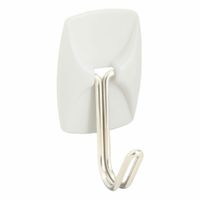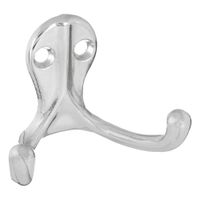Call +(254) 703 030 000 / 751 483 999 / 721 704 777
- Home
- Hardware
- Hooks Eye Pulleys Snap Hooks
- Utility Hooks
.....Read More
Frequently Asked Questions
What are utility hooks used for?
Utility hooks are versatile tools used for a variety of purposes across different contexts, primarily for organization, storage, and accessibility. In domestic settings, utility hooks are commonly employed to hang items such as coats, hats, keys, kitchen utensils, and towels, helping to keep spaces tidy and items easily accessible. In garages or workshops, they are used to organize tools, hoses, and other equipment, maximizing space and ensuring that tools are readily available when needed.
In retail environments, utility hooks are used to display merchandise efficiently, allowing customers to view and access products easily. This can enhance the shopping experience and potentially increase sales. In offices, utility hooks can help manage cables, hang office supplies, or organize personal items, contributing to a clutter-free workspace.
In the digital realm, particularly in software development, "utility hooks" can refer to reusable code components or functions that simplify complex tasks, enhance functionality, or improve performance. For example, in web development, hooks in frameworks like React allow developers to manage state and lifecycle features in functional components, promoting cleaner and more efficient code.
Overall, utility hooks serve the fundamental purpose of improving organization, accessibility, and efficiency, whether in physical spaces or digital environments. They are essential tools for optimizing space, enhancing functionality, and streamlining processes.
How do you install wall-mounted utility hooks?
1. **Select Location**: Choose a suitable spot on the wall where the hooks will be most functional. Ensure the wall can support the weight of the items you plan to hang.
2. **Gather Tools and Materials**: You will need a drill, screws, wall anchors (if not drilling into studs), a level, a pencil, a measuring tape, and the utility hooks.
3. **Mark the Position**: Use a measuring tape to determine the exact position for each hook. Mark these spots with a pencil. Use a level to ensure the marks are aligned horizontally.
4. **Locate Studs**: Use a stud finder to locate studs behind the wall. If you find a stud, you can drill directly into it for a more secure hold. If not, you will need to use wall anchors.
5. **Drill Pilot Holes**: For hooks going into studs, drill small pilot holes at the marked spots. For drywall, drill holes slightly smaller than the wall anchors.
6. **Insert Wall Anchors**: If not drilling into studs, insert wall anchors into the drilled holes. Tap them gently with a hammer until they are flush with the wall.
7. **Attach Hooks**: Align the utility hook with the pilot holes or wall anchors. Insert screws through the hook’s mounting holes and tighten them using a screwdriver or drill.
8. **Check Stability**: Ensure the hooks are securely fastened by gently tugging on them. They should not wobble or come loose.
9. **Clean Up**: Wipe away any pencil marks and clean up any dust or debris from drilling.
10. **Test**: Hang an item on the hook to test its strength and stability. Adjust if necessary.
Can adhesive-backed hooks hold heavy items?
Adhesive-backed hooks can hold heavy items, but their effectiveness depends on several factors, including the type of adhesive, the surface they are applied to, and the weight of the item. High-quality adhesive hooks, such as those using 3M's Command strips, are designed to hold significant weight, sometimes up to 7.5 pounds or more, depending on the specific product. However, for heavier items, it's crucial to choose hooks specifically rated for higher weights.
The surface is another critical factor. Adhesive hooks work best on smooth, clean, and dry surfaces like painted walls, tiles, or glass. Surfaces that are textured, dirty, or porous, such as brick or wallpaper, may not provide a strong bond, reducing the hook's weight capacity.
Proper installation is essential for maximizing the holding power of adhesive hooks. The surface should be cleaned with isopropyl alcohol to remove any dust or oils. After applying the hook, it's important to press firmly and allow the adhesive to set for the recommended time before hanging any items.
Temperature and humidity can also affect the adhesive's performance. Extreme temperatures or high humidity can weaken the adhesive bond, so it's advisable to avoid using adhesive hooks in areas like bathrooms or kitchens unless they are specifically designed for such environments.
For very heavy items, mechanical fasteners like screws or nails are generally more reliable. However, for moderately heavy items, using multiple adhesive hooks to distribute the weight can be an effective solution. Always check the manufacturer's guidelines for weight limits and installation instructions to ensure safety and effectiveness.
Are magnetic hooks safe for painted surfaces?
Magnetic hooks can be safe for painted surfaces, but several factors must be considered to ensure they do not cause damage. The safety largely depends on the strength of the magnet, the weight of the object being hung, the type of paint, and the condition of the painted surface.
1. **Magnet Strength**: Strong magnets can exert significant force, potentially pulling off paint if the surface is not adequately prepared or if the paint is old and brittle. It's crucial to choose a magnet with a strength appropriate for the weight it will support.
2. **Weight of the Object**: Overloading a magnetic hook can increase the risk of damage. Ensure the weight of the object does not exceed the magnet's capacity, as this can cause the hook to slide or fall, potentially chipping the paint.
3. **Type of Paint**: Different paints have varying levels of adhesion and durability. High-quality, well-adhered paint is less likely to be damaged by magnetic hooks. However, delicate or poorly adhered paint may be more susceptible to damage.
4. **Surface Condition**: A smooth, clean, and well-prepared surface is less likely to suffer damage. Dust, dirt, or uneven surfaces can reduce the magnet's effectiveness and increase the risk of paint damage.
5. **Protective Measures**: To minimize risk, consider using a protective barrier, such as a thin piece of felt or rubber, between the magnet and the painted surface. This can help distribute the magnetic force more evenly and reduce the risk of scratches or chips.
In summary, while magnetic hooks can be safe for painted surfaces, careful consideration of the factors above is essential to prevent damage. Always test the hook in an inconspicuous area first to ensure compatibility with your specific surface.
How do you remove adhesive hooks without damage?
To remove adhesive hooks without causing damage, follow these steps:
1. **Read Instructions**: Check the manufacturer's instructions for specific removal guidelines.
2. **Heat Application**: Use a hairdryer on a low to medium setting to gently heat the adhesive area for about 30 seconds. This softens the adhesive, making it easier to remove.
3. **Peel Slowly**: Start at one corner of the hook or strip. Gently peel it away from the wall. If resistance is felt, apply more heat.
4. **Use Dental Floss**: For stubborn hooks, slide a piece of dental floss behind the hook. Use a gentle sawing motion to cut through the adhesive.
5. **Adhesive Residue**: If any adhesive remains, apply a small amount of rubbing alcohol or adhesive remover to a cloth and gently rub the residue until it comes off.
6. **Clean the Surface**: Wipe the area with a damp cloth to remove any remaining adhesive remover or residue.
7. **Avoid Tools**: Do not use sharp tools or excessive force, as this can damage the wall surface.
8. **Test on Hidden Area**: Before using any chemicals, test them on a hidden area to ensure they do not damage the wall finish.
By following these steps, you can effectively remove adhesive hooks without damaging the wall surface.
What materials are suitable for magnetic hooks?
Magnetic hooks are versatile tools used for hanging objects on metal surfaces. The materials suitable for magnetic hooks primarily include:
1. **Magnets**: The core component of magnetic hooks is the magnet itself. The most common types of magnets used are:
- **Neodymium Magnets**: Known for their strong magnetic force, neodymium magnets are ideal for heavy-duty applications. They are made from an alloy of neodymium, iron, and boron.
- **Ferrite Magnets**: Also known as ceramic magnets, these are less powerful than neodymium but are more cost-effective and suitable for lighter applications.
2. **Hook Material**: The hook attached to the magnet can be made from various materials, including:
- **Stainless Steel**: Offers excellent corrosion resistance and strength, making it suitable for both indoor and outdoor use.
- **Aluminum**: Lightweight and resistant to corrosion, aluminum hooks are ideal for applications where weight is a concern.
- **Plastic or Nylon**: Used for lightweight applications, these materials are non-conductive and resistant to moisture.
3. **Coating and Plating**: To enhance durability and prevent corrosion, magnetic hooks often have coatings such as:
- **Nickel or Zinc Plating**: Provides a shiny finish and protects against rust and wear.
- **Epoxy Coating**: Offers additional protection against moisture and chemicals, suitable for harsh environments.
4. **Base Material**: The base that houses the magnet can be made from:
- **Steel**: Provides a strong backing that enhances the magnetic force.
- **Plastic**: Used for lightweight applications, offering insulation and protection.
These materials collectively ensure that magnetic hooks are strong, durable, and suitable for a wide range of applications, from industrial to household use.
How much weight can utility hooks support?
Utility hooks can support varying amounts of weight depending on their design, material, and installation method. Generally, lightweight utility hooks made of plastic or thin metal can support around 5 to 10 pounds, suitable for hanging small items like keys, hats, or lightweight decorations. Medium-duty hooks, often made of stronger metals like steel or reinforced plastic, can typically hold between 15 to 25 pounds, making them ideal for items such as coats, small bags, or kitchen utensils.
Heavy-duty utility hooks, designed for more substantial loads, can support weights ranging from 30 to 50 pounds or more. These are often constructed from robust materials like stainless steel or heavy-duty plastic and are suitable for hanging larger items such as bicycles, ladders, or heavy tools. Some specialized heavy-duty hooks, particularly those used in garages or workshops, can support even greater weights, sometimes exceeding 100 pounds, depending on the wall material and the type of anchor used.
The weight capacity of a utility hook also depends significantly on the installation surface and method. Hooks installed in drywall without proper anchors may support less weight compared to those secured into studs or solid wood. Using appropriate wall anchors, such as toggle bolts or molly bolts, can enhance the weight-bearing capacity of hooks installed in drywall or hollow walls.
It's crucial to follow the manufacturer's guidelines regarding weight limits and installation instructions to ensure safety and effectiveness. Overloading hooks beyond their specified capacity can lead to failure, potentially causing damage or injury. Always consider both the hook's specifications and the installation environment when determining the appropriate utility hook for your needs.


